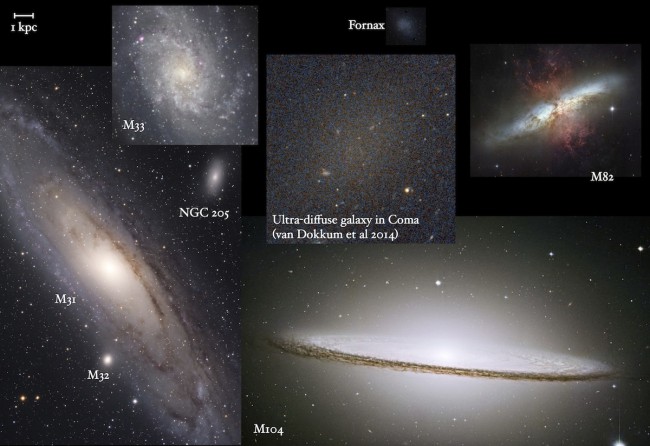Hubble imaging picked up one of the dark galaxies serendipitously. The galaxy's smattering of red stars is barely visible against the backdrop. The image compares sizes to several well known galaxies, if they were at the same distance in the Coma Cluster. Pieter van Dokkum & others
A bizarre set of galaxies in the Coma Cluster have lost most of their stars (or star-making material), making them especially rich in dark matter.
The Coma Cluster, visible in the evening skies of spring and summer, reveals its jewel box to large backyard telescopes: several thousand galaxies sardine-packed into a space only 20 million light-years across.
But there’s more to the Coma Cluster than meets the eye — or the backyard telescope.
Pieter van Dokkum (Yale University) and colleagues took a unique look at Coma through the Dragonfly Telephoto Array, eight Canon telephoto lenses coupled to CCD cameras. The Dragonfly is designed to find faint, fuzzy blobs, but what its images revealed surprised the team.
On Coma’s outskirts lurk 47 galaxies similar in size to the Milky Way — but with 1,000 times fewer stars. To survive in crowded Coma, these dark galaxies must contain 98% dark matter to hold themselves together, much higher than the fraction in the universe at large (73%).
Near or Far?
The galaxies’ size depends on their distance, so to make sure this result wasn’t just a trick of perspective, van Dokkum and colleagues had to make sure these galaxies really belonged to the Coma cluster, more than 300 million light-years away. If they turned out to live nearby, the galaxies’ size would be akin to regular ol’ dwarf galaxies.
Determining cluster membership was a challenge because the objects are far too faint to study in the usual ways, such as taking a spectrum to determine their distance. Nonetheless, “van Dokkum and his co-authors make quite a convincing case,” says Mark den Brok (University of Utah).
The authors initially expected the galaxies to be distributed randomly, as they would be if they lay in the foreground near the Milky Way. Instead, the galaxies cluster around the center of the image in the cluster’s periphery. The discovery of a serendipitous Hubble image of one of the galaxies strengthened the team’s case, den Brok says, definitively showing that it doesn’t have the traits of a nearby dwarf galaxy.

